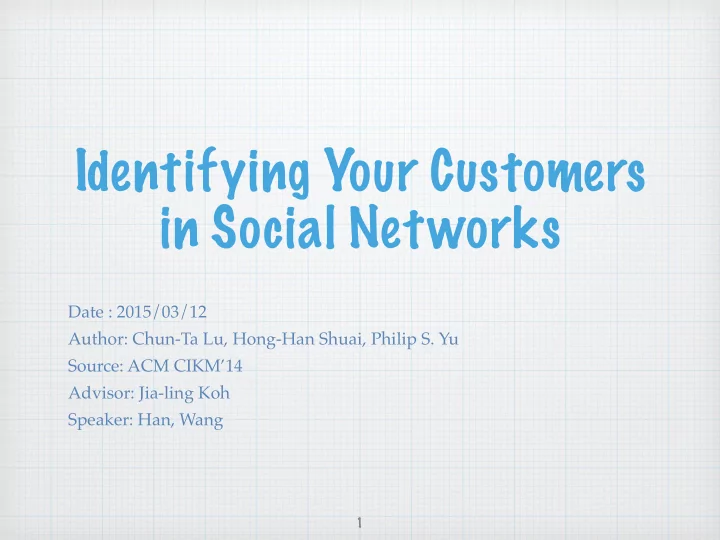

Identifying Your Customers in Social Networks Date : 2015/03/12 � Author: Chun-Ta Lu, Hong-Han Shuai, Philip S. Yu � Source: ACM CIKM’14 � Advisor: Jia-ling Koh � Speaker: Han, Wang 1
Outline Introduction Approach Experiments Conclusion 2
Introduction Motivation : � Social networks are influential sources in shaping a customer’s attitudes and behaviors. � Interactions with friends in social networks of customers are barely observable in most e-commerce companies. What did Emma Watson buy? Who bought a iPhone 6? 3
Introduction Purpose : � To fulfill the gap between companies and social networks. � Find the one-to-one pair between two networks. 4
Introduction Challenges : � Difference in network schema. � Partially aligned networks. Heterogeneous network i Phone 6 PSP i Pad NDS Bipartite 5
Outline Introduction Approach Experiments Conclusion 6
Approach Notation: i Phone 6 PSP i Pad NDS 7
Approach Problems : � How to extract informative features for the customer identification task using basic information available in most e-commerce sites? � � How to effectively match all the customers, who can be identified in social networks, to their corresponding social accounts? 8
Approach Framework: Customer-Social Identification (CSI) Input 1. Extracting features across Output networks with different gc, gs, � schema � A(identified A’ � 2. Identifying customers in pairs) � (predicted partially aligned networks K(user-specified pairs) value) 9
Approach Extract features : (user profile similarity) � Names: (five features) � • Exact username match � • Jaccard similarity � • Distance traveled when typing keyboard � • Longest common sequence � Levenshtein edit distance � • Levenshtein edit distance � Ex: Kitten -> Sitting � sitten ( k → s) � Email Address: � sittin ( e → i ) � For verification of identification. sitting (→ g ) 10
Approach Extract features : (user interest similarity) i Phone 6 PSP i Pad NDS 2) Jaccard’s Coefficient (JC) 1) Common Interest (CI) 11
Approach Extract features : (user interest similarity) i Phone 6 PSP i Pad NDS 4) Resource Allocation Index (RA) 3) Admic/Adar Index(AA) i Phone 6 i Pad i Phone 6 i Pad 12
Approach Extract features : (user interest similarity) i Phone 6 PSP i Pad NDS 3) Katz’s Index: (Set lmax =2) 13
Approach Identifying customers : � top-K maximum similarity & stable matching problem threshold = 0.5 ignore candidate pair when K=1 14
Approach Identifying customers : 1. Select the pair of accounts with the maximum similarity score from candidate pairs. � 2. If both the users in pair haven’t assigned to any account, add pair to A’ , and set accounts as occupied. � 3. Doing until finding top K pairs or no left in A . 15
Outline Introduction Approach Experiments Conclusion 16
Experiments Dataset : (Kickstarter v.s Twitter) � from Nov. 2012 to Sep. 2013 (10 months) � Twitter:(Regarding Kickstarter) � • 385K tweets, 178K users, 5.4 million social links, 3725 projects and 234K links between projects and Twitter users. � Kickstarter: � • 3725 projects, 545K customers and 868K adoption links. 17
Experiments Comparative methods � Unsupervised Link Prediction � Supervised Link Prediction � Customer-Social Identification (CSI) � � Evaluation Measures: Precision,Recall, F1-measure and ROC curve(AUC) 18
Experiments 5-fold cross validation � unsupervised methods. 19
Experiments 20
Experiments 21
Experiments 22
Outline Introduction Approach Experiments Conclusion 23
Conclusion This paper described and studied the problem of customer identification in social networks. � Extract two types of features, user profile and user interest, that can be used to compute the similarity scores of pairs between networks. � CSI Approach can effectively connect customers and accounts in social network, and outperforms other commonly-used baseline on customer identification. 24
Recommend
More recommend